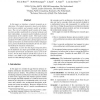Free Online Productivity Tools
i2Speak
i2Symbol
i2OCR
iTex2Img
iWeb2Print
iWeb2Shot
i2Type
iPdf2Split
iPdf2Merge
i2Bopomofo
i2Arabic
i2Style
i2Image
i2PDF
iLatex2Rtf
Sci2ools
EDOC
2004
IEEE
2004
IEEE
A Logical Viewpoint on Architectures
In this paper we introduce a logical viewpoint on architectures. The logical viewpoint is based on the distinction between symbolic and semantic models of architectures. The core of a symbolic model consists of its signature that specifies symbolically its structural elements and their relationships. A semantic model is defined as a formal interpretation of the symbolic model. This leads to more precise characterization of the concepts introduced in IEEE standard 1471-2000, and provides a formal approach to the design of enterprise of architectural description languages and a general mathematical foundation for the use of formal methods in enterprise architectures. Additionally, we show how this logical viewpoint allows for the definition of a simple general XML language for the description of both static and dynamic aspects of an architecture. For the meta-analysis of both these aspects we introduce a new XML tool for general XML transformations based on a Rule Markup Language.
Distributed And Parallel Computing | EDOC 2004 | Logical Viewpoint | Semantic Model | Symbolic Model |
| Added | 20 Aug 2010 |
| Updated | 20 Aug 2010 |
| Type | Conference |
| Year | 2004 |
| Where | EDOC |
| Authors | Frank S. de Boer, Marcello M. Bonsangue, Joost Jacob, Andries Stam, Leendert W. N. van der Torre |
Comments (0)

